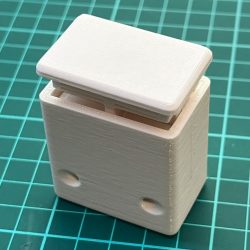When one needs a spring, a 3D-printed version is maybe not one’s first choice. It might even be fair to say that printed springs are something one ends up making, rather than something one sets out to use. That might change once you try the spring design in [the_ress]’s 3D-printed filament cutter with printed springs.
 The filament cutter works like this: filament is inserted into the device through one of the pairs of holes at the bottom. To cut the filment, one presses down on the plunger. This pushes a blade down to neatly cut the filament at an angle. The cutter is the device’s only non-printed part; a single segment from an 18 mm utility knife blade.
The filament cutter works like this: filament is inserted into the device through one of the pairs of holes at the bottom. To cut the filment, one presses down on the plunger. This pushes a blade down to neatly cut the filament at an angle. The cutter is the device’s only non-printed part; a single segment from an 18 mm utility knife blade.
The springs are of particular interest, and don’t look quite like a typical spring. They take their design from this compliant linear motion mechanism documented on reprap.org, and resemble little parallel 4-bar linkages. These springs have limited travel, but are definitely springy enough for the job they need to do, and that’s the important part.
Want a more traditional coiled spring? Annealing filament wound around a mandrel can yield useful results, and don’t forget the fantastic mechanisms known as flexures; they have clear similarities to the springs [the_ress] used. You can see her design in action in the short video, embedded below.
Continue reading “Filament Cutter Uses Unusual (But Effective) 3D-Printed Spring Design”












